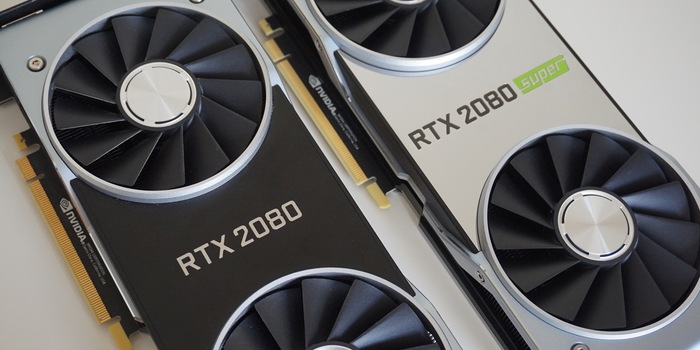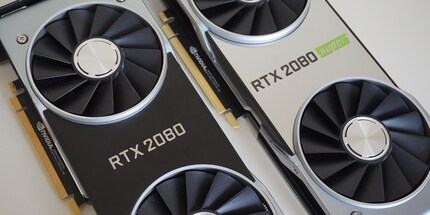
The Nvidia RTX 2080 also has a new "Super" flavour
More shader cores and a higher clock rate make the RTX 2080 Super slightly faster than the non-Super card. However, this comes at the expense of power consumption. Read on to find out why the Super model is still interesting.
After the RTX 2060 and 2070, Nvidia is also following up with the 2080 and introducing the Geforce RTX 2080 Super version. With the exception of the 2080 Ti, all of Nvidia's current graphics cards have now been released in a new edition. Did Nvidia overestimate the competition - the AMD RX 5700 XT? Or is the chip yield of its own TU104 graphics processors so strong that it no longer needs to be artificially capped? Whatever the question, the RTX 2080 Super is the answer.
What's inside
The RTX 2080 is supposed to be the card that everyone has been waiting for: finally with a full shader count, high-clocked memory and at a price that is only slightly higher than its predecessor. AMD has done a great job with the RX 5700 XT: The benchmarks make you sit up and take notice. Nvidia wanted - or needed - to up the ante and has done so with the 2080 Super. As far as the specifications are concerned, the whole thing doesn't read too bad.

The same chip is installed as in the 2070 and 2080 models, the well-known TU104 chip. For the first time, the non-professional sector also gets a card with more shader units: There are now 3072 instead of the previous 2944. The GDDR6 video memory is overclocked at a relatively high 7.75 GHz - no other manufacturer can currently boast a higher value - and as is usual for Nvidia, a 256-bit interface is used.
The 2080 Super consumes more power, about as much as the RTX 2080 Ti. However, it is much faster and therefore more efficient. With the boost clock beyond the 1800 MHz limit, Nvidia seems to have set a frequency beyond the sweet spot, which is slowed down by its own watt power limit. Custom designs will hopefully remedy this shortcoming. In terms of the circuit board, the Super model is almost identical to its smaller RTX 2080 brother. Only the two fans are slightly louder under load due to the higher waste heat.
How good is "Super"?
Golem has already tested the card. With a Core i9-9900K, 16 GB DDR4-2667 RAM, a 1 TB WD Black SN750 and the latest driver for the graphics cards, it was given a test run. In terms of frame rates, the Super version achieves around five per cent higher values compared to the normal 2080 model. This puts it almost 30 per cent above the Radeon RX 5700 XT when playing at 1440p or 4K. The 2080 Ti version is 20 per cent ahead of the 2080 Super, provided it is not limited by the processor.
With hardware-accelerated ray tracing in "Battlefield 5" (with 1440p and ultra-detail), the frame rate of the RTX 2080 Super drops from 105 to 65, in Metro Exodus with the same settings from 59 to 43 fps and in "Shadow of the Tomb Raider" from 91 to 52 frames per second. The power consumption is not surprising: In idle mode, the 2080 Super is as economical as the Radeon at around 10 watts, and under load it even consumes slightly more than Nvidia specifies at 254 watts. As with all other cards, the energy requirement depends on how high the load actually is: with 60 Hz Vsync, for example, you consume well under 200 watts.
From the latest iPhone to the return of 80s fashion. The editorial team will help you make sense of it all.
Show all